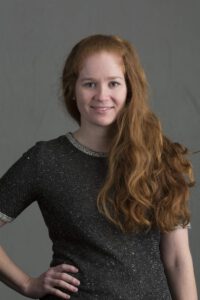This interview is part of an occasional series of profiles introducing you to  some of 23andMe’s scientists behind 23andMe’s research. Senior Scientist and Population Geneticist Kasia Bryc is originally from Lublin, Poland, but grew up in Cincinnati, Ohio. As an undergraduate Kasia studied mathematics and computational science at Stanford and went on to Cornell for her PhD, where she studied with Carolos Bustamante.
some of 23andMe’s scientists behind 23andMe’s research. Senior Scientist and Population Geneticist Kasia Bryc is originally from Lublin, Poland, but grew up in Cincinnati, Ohio. As an undergraduate Kasia studied mathematics and computational science at Stanford and went on to Cornell for her PhD, where she studied with Carolos Bustamante.
Her research there focused on the ancestry of African Americans and Latinos. For her post-doctoral studies Kasia worked in David Reich’s lab at Harvard Medical School. At 23andMe she has been involved in several ancestry related projects and research. Her paper on the genetic ancestry of African Americans, Latinos and European Americans across the United States offered the first of its kind genetic portrait of the U.S.
Tell us about your education:
As an undergraduate at Stanford I studied mathematical and computational Science, and then went to graduate school at Cornell. My PhD is technically in Biometry, which is a broad field applying statistics to questions in biology, but I basically studied population genetics because I was so enamored with it.
What’s your job title and role here at 23andMe?
As a population geneticist, I work on the methods that drive 23andMe’s ancestry-related reports and tools in the consumer product.
Title: Senior Scientist, Population Genetics.
Originally From: Lublin, Poland but grew up in Cincinnati, Ohio
Degree and Institution: B.A. from Stanford, PhD from Cornell
Post Doc: Harvard Medical School
Fun Fact: I make a mean cherry pie.
What were you researching before you came to 23andMe?
I was a National Institutes of Health Ruth L. Kirschstein National Research Fellow at Harvard Medical School before coming to 23andMe. While at Harvard I researched methods for understanding genetic diversity, and looking at admixture. Admixture is the population genetic term for when two previously separate populations start mixing together, which turns out to have happened a lot in human history.
What are you working on now at 23andMe?
I’m part of the team innovating new tools for the ancestry product. We are always looking to improve our Ancestry Composition and DNA Relatives features! I’ve also given a lot of talks to genealogists, which is always fun. I’ve found that they often are quite enthusiastic about genetic testing since it’s such a revolutionary tool, and completely different from traditional paper trail and record searches.
Why are you excited about genetics?
I’ve always loved thinking about evolution, and, in a broad sense, understanding how people came to be just how they are now. Indeed, each one of us is the result of millions of years of successful experiments – each of your genealogical ancestors passed down their genes, and their successes contributed to you becoming you. Genetics is a window not just into your genealogical ancestors who contributed DNA to you, but also into this evolutionary process, and how you are, well… you. It’s how I have red hair or bits of Ashkenazi ancestry.
Tell us about one of your interesting findings at 23andMe, or in your previous scientific life.
Population geneticists often study populations or groups of individuals living around the world to understand genetic patterns and get insights into human history. Joanna Mountain, Senior Director of Research at 23andMe and a fellow population geneticist, and I saw an opportunity to try to begin to understand the patterns of genetic variation that you see in individuals living in the United States today. We looked at how people self-identify compared to the genetic ancestry they carry. We were fascinated to see history of the US, with its complex historical migration patterns, reflected in the DNA of individuals living across different states. We also saw that appreciable numbers of individuals who identified as European Americans, or white, carried segments of Native American and African ancestry.
Tell us about a recent breakthrough in genetics research that you think will have a big impact on the industry.
There are so many breakthroughs. It’s an exciting time to be a geneticist! Every day there are new associations of genetic markers with disease, or new findings give us a better understanding of the etiology or landscape of genetics. Each of these papers are moving us one step forward to understanding the pathways and the biology, which will eventually help drive development of better treatments.
One interesting fact people don’t usually guess about me is:
I’m actually very good with power tools. Even though my husband is just as good, I think I enjoy it more, so I’m the handyman around the house whenever anything needs fixing.
What’s one thing the average consumer should know about genetics?
I think 23andMe’s slogan “Welcome to You” is right on. This IS you! It’s like being able to peek inside yourself, to check out your own DNA. And that DNA has so much information about your own history (including your ancestors, your relatives, and your ancestry), as well as traits, and health related results. It is very cool to have access to this kind of information, something that was in the realm of science fiction up until ten years ago!